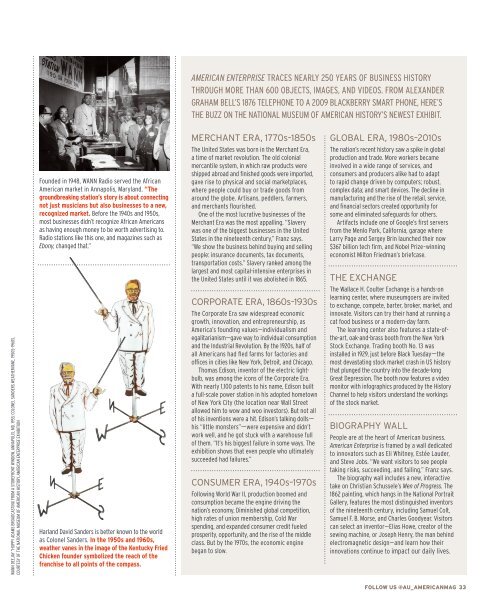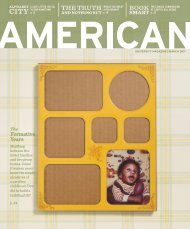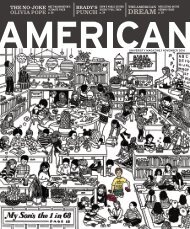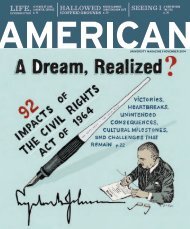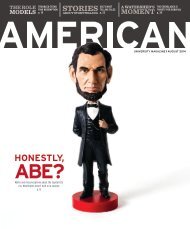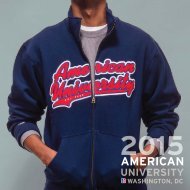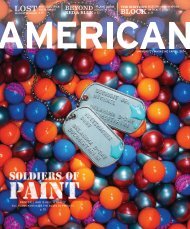American Magazine, July 2015
This issue, meet Maryland First Lady Yumi Hogan, learn about Kogod’s startup incubator, explore the Smithsonian’s new American Enterprise exhibit, hop on the Metro to Navy Yard—Ballpark, and get to know some of AU’s 1,200 Atlanta transplants. Also in the August issue: footwear on campus, 12 Eagles to follow on Twitter, and a new quiz with a tasty prize.
This issue, meet Maryland First Lady Yumi Hogan, learn about Kogod’s startup incubator, explore the Smithsonian’s new American Enterprise exhibit, hop on the Metro to Navy Yard—Ballpark, and get to know some of AU’s 1,200 Atlanta transplants. Also in the August issue: footwear on campus, 12 Eagles to follow on Twitter, and a new quiz with a tasty prize.
Create successful ePaper yourself
Turn your PDF publications into a flip-book with our unique Google optimized e-Paper software.
AMERICAN ENTERPRISE TRACES NEARLY 250 YEARS OF BUSINESS HISTORY<br />
THROUGH MORE THAN 600 OBJECTS, IMAGES, AND VIDEOS. FROM ALEXANDER<br />
GRAHAM BELL’S 1876 TELEPHONE TO A 2009 BLACKBERRY SMART PHONE, HERE’S<br />
THE BUZZ ON THE NATIONAL MUSEUM OF AMERICAN HISTORY’S NEWEST EXHIBIT.<br />
MERCHANT ERA, 1770s–1850s<br />
GLOBAL ERA, 1980s–2010s<br />
WANN DEEJAY “HOPPY ADAMS BROADCASTING FROM A STOREFRONT WINDOW, ANNAPOLIS, MD, 1953; COLONEL SANDERS WEATHERVANE, 1950S–1960S,<br />
COURTESY OF THE NATIONAL MUSEUM OF AMERICAN HISTORY, AMERICAN ENTERPRISE EXHIBITION<br />
Founded in 1948, WANN Radio served the African<br />
<strong>American</strong> market in Annapolis, Maryland. “The<br />
groundbreaking station’s story is about connecting<br />
not just musicians but also businesses to a new,<br />
recognized market. Before the 1940s and 1950s,<br />
most businesses didn’t recognize African <strong>American</strong>s<br />
as having enough money to be worth advertising to.<br />
Radio stations like this one, and magazines such as<br />
Ebony, changed that.”<br />
Harland David Sanders is better known to the world<br />
as Colonel Sanders. In the 1950s and 1960s,<br />
weather vanes in the image of the Kentucky Fried<br />
Chicken founder symbolized the reach of the<br />
franchise to all points of the compass.<br />
The United States was born in the Merchant Era,<br />
a time of market revolution. The old colonial<br />
mercantile system, in which raw products were<br />
shipped abroad and finished goods were imported,<br />
gave rise to physical and social marketplaces,<br />
where people could buy or trade goods from<br />
around the globe. Artisans, peddlers, farmers,<br />
and merchants flourished.<br />
One of the most lucrative businesses of the<br />
Merchant Era was the most appalling. “Slavery<br />
was one of the biggest businesses in the United<br />
States in the nineteenth century,” Franz says.<br />
“We show the business behind buying and selling<br />
people: insurance documents, tax documents,<br />
transportation costs.” Slavery ranked among the<br />
largest and most capital-intensive enterprises in<br />
the United States until it was abolished in 1865.<br />
CORPORATE ERA, 1860s–1930s<br />
The Corporate Era saw widespread economic<br />
growth, innovation, and entrepreneurship, as<br />
America’s founding values—individualism and<br />
egalitarianism—gave way to individual consumption<br />
and the Industrial Revolution. By the 1920s, half of<br />
all <strong>American</strong>s had fled farms for factories and<br />
offices in cities like New York, Detroit, and Chicago.<br />
Thomas Edison, inventor of the electric lightbulb,<br />
was among the icons of the Corporate Era.<br />
With nearly 1,100 patents to his name, Edison built<br />
a full-scale power station in his adopted hometown<br />
of New York City (the location near Wall Street<br />
allowed him to wow and woo investors). But not all<br />
of his inventions were a hit. Edison’s talking dolls—<br />
his “little monsters”—were expensive and didn’t<br />
work well, and he got stuck with a warehouse full<br />
of them. “It’s his biggest failure in some ways. The<br />
exhibition shows that even people who ultimately<br />
succeeded had failures.”<br />
CONSUMER ERA, 1940s–1970s<br />
Following World War II, production boomed and<br />
consumption became the engine driving the<br />
nation’s economy. Diminished global competition,<br />
high rates of union membership, Cold War<br />
spending, and expanded consumer credit fueled<br />
prosperity, opportunity, and the rise of the middle<br />
class. But by the 1970s, the economic engine<br />
began to slow.<br />
The nation’s recent history saw a spike in global<br />
production and trade. More workers became<br />
involved in a wide range of services, and<br />
consumers and producers alike had to adapt<br />
to rapid change driven by computers; robust,<br />
complex data; and smart devices. The decline in<br />
manufacturing and the rise of the retail, service,<br />
and financial sectors created opportunity for<br />
some and eliminated safeguards for others.<br />
Artifacts include one of Google’s first servers<br />
from the Menlo Park, California, garage where<br />
Larry Page and Sergey Brin launched their now<br />
$367 billion tech firm, and Nobel Prize-winning<br />
economist Milton Friedman’s briefcase.<br />
THE EXCHANGE<br />
The Wallace H. Coulter Exchange is a hands-on<br />
learning center, where museumgoers are invited<br />
to exchange, compete, barter, broker, market, and<br />
innovate. Visitors can try their hand at running a<br />
cat food business or a modern-day farm.<br />
The learning center also features a state-ofthe-art,<br />
oak-and-brass booth from the New York<br />
Stock Exchange. Trading booth No. 13 was<br />
installed in 1929, just before Black Tuesday—the<br />
most devastating stock market crash in US history<br />
that plunged the country into the decade-long<br />
Great Depression. The booth now features a video<br />
monitor with infographics produced by the History<br />
Channel to help visitors understand the workings<br />
of the stock market.<br />
BIOGRAPHY WALL<br />
People are at the heart of <strong>American</strong> business.<br />
<strong>American</strong> Enterprise is framed by a wall dedicated<br />
to innovators such as Eli Whitney, Estée Lauder,<br />
and Steve Jobs. “We want visitors to see people<br />
taking risks, succeeding, and failing,” Franz says.<br />
The biography wall includes a new, interactive<br />
take on Christian Schussele’s Men of Progress. The<br />
1862 painting, which hangs in the National Portrait<br />
Gallery, features the most distinguished inventors<br />
of the nineteenth century, including Samuel Colt,<br />
Samuel F. B. Morse, and Charles Goodyear. Visitors<br />
can select an inventor—Elias Howe, creator of the<br />
sewing machine, or Joseph Henry, the man behind<br />
electromagnetic design—and learn how their<br />
innovations continue to impact our daily lives.<br />
FOLLOW US @AU_AMERICANMAG 33


